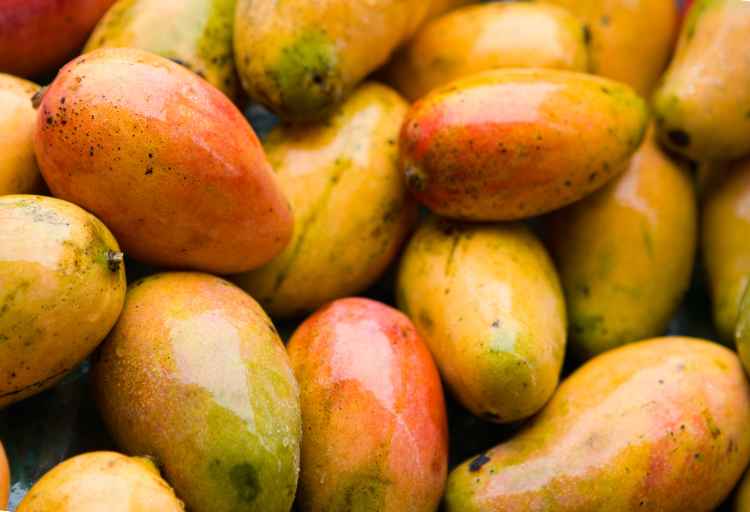What Happens If You Eat a Bad Mango? Risks and Precautions
Mangoes are delicious and nutritious tropical fruits enjoyed by millions around the world. Bursting with flavor and rich in vitamins and antioxidants, mangoes are a favorite summer treat.
However, like any perishable food, mangoes can go bad if not handled and stored properly.
What happens if you eat a bad mango? Consuming a bad mango can lead to gastrointestinal discomfort, food poisoning due to harmful bacteria, and potential allergic reactions from mold and fungi. Symptoms may include nausea, vomiting, diarrhea, fever, and skin irritations. It’s crucial to inspect, wash, and store mangoes properly to avoid these risks.

Contents
What happens if you eat a bad mango? Understanding Mango Spoilage
Mangoes, like all fruits, have a limited shelf life. They can start to spoil due to factors such as improper storage, damage during handling, or exposure to heat and moisture.
Spoilage can lead to changes in color, texture, and taste. When a mango goes bad, its flesh might become mushy, discolored, and emit an unpleasant odor.
Risks of Consuming Bad Mangoes
While consuming a slightly overripe mango might not pose significant health risks for most people, eating a truly bad mango – one that has mold, has a foul odor, or is visibly rotten – can potentially lead to health issues.
The most common risks associated with eating a bad mango include:
Gastrointestinal Distress:
- Consuming spoiled food, including mangoes, can lead to gastrointestinal discomfort such as nausea, vomiting, diarrhea, and stomach cramps.
- The bacteria and mold present in a bad mango can irritate the digestive system and cause these symptoms.
Food Poisoning:
- Bad mangoes can carry harmful bacteria like Salmonella, E. coli, and Listeria. Ingesting these bacteria can result in food poisoning, characterized by symptoms such as fever, abdominal pain, and dehydration.
- People with weakened immune systems, the elderly, and young children are particularly vulnerable to foodborne illnesses.
Allergic Reactions:
- Mold and fungi present in a bad mango can trigger allergic reactions in some individuals. This can range from mild symptoms like itching and hives to more severe reactions that require medical attention.
Symptoms of Consuming Bad Mangoes
If you’ve accidentally consumed a bad mango, you might experience the following symptoms:
Digestive Issues:
- Nausea, vomiting, diarrhea, and stomach cramps are common signs of gastrointestinal distress caused by consuming spoiled mangoes.
Fever and Weakness:
- In cases of food poisoning, symptoms can escalate to fever, weakness, and fatigue as the body tries to fight off the harmful bacteria.
Allergic Reactions:
- Itchy skin, redness, hives, and in severe cases, difficulty breathing and anaphylaxis might occur as a result of an allergic reaction.
Precautions to Take
To ensure that your mango-eating experience remains safe and enjoyable, follow these precautions:
Inspect Before Consumption:
- Always inspect mangoes before eating. Look for any signs of mold, unusual discoloration, or a strong off-putting odor. If any of these are present, it’s best to discard the mango.
Proper Storage:
- Store ripe mangoes in the refrigerator to slow down the ripening process and extend their shelf life. If a mango is about to ripen, you can place it in a paper bag to speed up the process.
Wash Thoroughly:
- Before cutting into a mango, wash it thoroughly with water and a mild vegetable wash. This helps remove dirt, bacteria, and pesticide residues from the skin.
Practice Hygiene:
- Wash your hands and any utensils you’ll be using to handle and cut the mango. Cross-contamination from contaminated surfaces can lead to foodborne illnesses.
Avoid Cutting Around Mold:
- If you notice mold on a mango, don’t try to salvage the unaffected parts by cutting around it. The mold might have already spread to the rest of the fruit.
Consume Promptly:
- Once a ripe mango is ready to eat, consume it promptly. Avoid leaving ripe mangoes at room temperature for extended periods to prevent spoilage.
Conclusion
Mangoes are a delightful and healthy addition to your diet, but it’s essential to be mindful of their freshness and quality.
Eating a bad mango can lead to various health risks, including gastrointestinal distress, food poisoning, and allergic reactions.
By practicing proper food safety measures, such as inspecting mangoes before consumption, washing them thoroughly, and storing them correctly, you can minimize the chances of encountering a bad mango.
Remember that when in doubt, it’s better to err on the side of caution and opt for a fresh, ripe mango to fully enjoy its delectable flavor and numerous benefits.
FAQs About Eating a Bad Mango
Can eating a bad mango make you sick?
Yes, consuming a spoiled mango can lead to gastrointestinal issues, food poisoning, and allergic reactions due to mold and harmful bacteria present on the fruit.
What are the signs of a bad mango?
Look for mold growth, unusual discoloration, or a strong, unpleasant odor. These are indicators that the mango has gone bad and should not be consumed.
What happens if you accidentally eat a moldy part of a mango?
Eating a moldy part of a mango can potentially lead to stomach upset and allergic reactions. It’s best to discard the entire mango if you spot mold.
How can you prevent illness from bad mangoes?
To prevent illness, inspect mangoes before eating, wash them thoroughly, store them in the refrigerator, and practice proper hygiene when handling and cutting.
Can you get food poisoning from slightly overripe mangoes?
While slightly overripe mangoes may not cause severe food poisoning, consuming truly bad mangoes, especially those with visible mold and foul odor, can increase the risk of foodborne illnesses.






